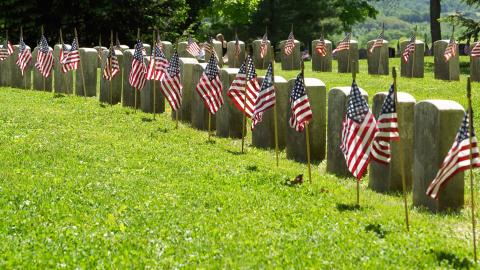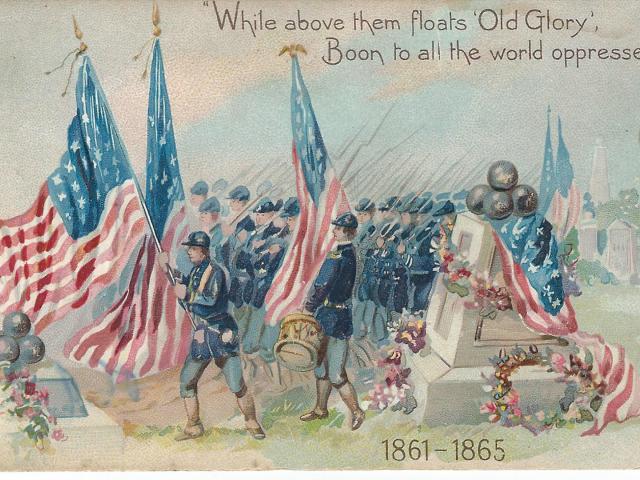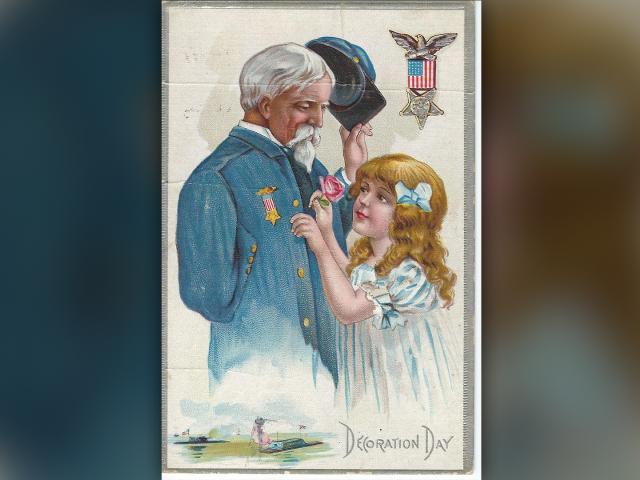
Before Memorial Day: For 50+ Years, 'Decoration Day' was Observed to Honor and Remember Civil War Dead
Before it became the national holiday we now know as Memorial Day, it was a day observed across the country as Decoration Day, a day which was celebrated for more than five decades to honor both the Union and Confederate dead from the Civil War.
In 1868, Major Gen. John A. Logan, a former Union Army corps commander, and now the commander of the Grand Army of the Republic (G.A.R.), a fraternal organization of Union veterans, issued a proclamation for a celebration to be held to honor the soldiers who died "in defense of their country during the late rebellion."

On the first national celebration of Decoration Day observed on May 30, 1868, former Union major general and now Ohio Republican Congressman James A. Garfield spoke at Arlington National Cemetery to an audience of more than 5,000. His was the first of annual addresses that explained why Decoration Day should be commemorated.
After the ceremony, children from the Soldiers' and Sailors' Orphan Home and members of the GAR made their way through the cemetery, placing flowers on both Union and Confederate graves.
Across the nation, many cities and towns also joined in for the national day of observance on May 30 holding their own events, including a parade where citizens would watch the aging veterans who once wore the blue and the gray proudly march by.

Editors Note: The Decoration Day postcards throughout this article show the patriotism that was seen in cities and towns throughout the country in the late 19th and early 20th centuries. All of the images courtesy of the author's collection.
However, this Decoration Day observance was not the first. Local communities had decorated the graves of their war dead with flowers before and during the war. In fact, several cities claim to be the birthplace of what we now call Memorial Day. These include Columbus, Mississippi; Macon, Georgia; Richmond, Virginia; Boalsburg, Pennsylvania; and Carbondale, Illinois.

But of course, there can be only one.
Richard Gardiner, an associate professor at Columbus State University in Georgia, revealed in a book he co-authored, The Genesis of the Memorial Day Holiday, that the real honor of observing the first organized Decoration Day goes to Columbus, Georgia. In January of 1866, the Ladies' Memorial Association in Columbus, passed a motion designating a day to throw flowers on the graves of soldiers buried at the local cemetery.
Mary Ann Williams, the group's secretary, wrote a letter about the event they were planning and sent it to newspapers all over the United States, Gardiner told Live Science in 2016.

"You'll find that letter in dozens of newspapers," Gardiner said. "It got out, and it was republished everywhere in the country."
In their letter, the ladies asked people to celebrate the war's fallen heroes on April 26, which was the same day Confederate forces surrendered in North Carolina in 1865.
"That's what many people in the South considered to be the end of the war," Gardiner told Live Science. Even though Gen. Robert E. Lee surrendered on April 9, "there were still 90,000 people ready to fight. And until those 90,000 surrendered on April 26, the war was effectively still going on," Gardiner said.
Many people across the South read Williams' published letter and on April 26, 1866, many began decorating the graves of Confederate soldiers. However, these same people also noticed the graves of Union soldiers remained flowerless.

"They start to see these Union graves that are just laying there, kind of barren," Gardiner noted. "Their hearts are warmed. Their hearts start to feel bad for the mothers who have lost these children. So, they start to throw flowers on the Yankee graves. And then that story gets published everywhere."
Southern folks continued the practice in 1867 and 1868. When Decoration Day became a federal holiday in 1868, getting the flowers to decorate the graves in the northern states presented a problem, so the federal government moved it to May 30, so that people could decorate the war dead with wildflowers, according to Gardiner.
And as the years passed after "The Great Unpleasantness" as the Civil War was sometimes referred to in the press, old hatreds dissolved, and hearts once hardened by war were softened with the passing of time.

In one instance, a few lines written on a small piece of paper is all it took to melt a few hearts. The committee in Lafayette, Ind., organizing the city's Decoration Day ceremonies in 1868 received a wreath made of flowers from a local girl. She had attached a short note, according to the Andersonville National Historic Site operated by the National Park Service in Georgia.
"Will you please put this wreath upon some rebel soldier's grave. My dear papa is buried at Andersonville, and perhaps some little girl will be kind enough to put a few flowers upon his grave. -- Jennie Vernon"
Newspapers across the country picked up the story of Jennie's note and one, The Mobile Register, also added another paragraph.

"The wreath was deposited on the grave of an unknown Confederate soldier, the only one remaining in the cemetery. God bless little Jennie!" the newspaper added to their edition published on June 18, 1868.
The story of the girl's kind gesture was reprinted throughout the nation that summer. Vernon was the daughter of Sgt. Samuel James Walker Vernon, Company K of the 7th Pennsylvania Cavalry. He died in June of 1864 at the Camp Sumter military prison located near Andersonville and is now buried in the Andersonville National Cemetery. It is not known if Jennie's gesture was returned in 1868.

In this real photo postcard, Civil War veterans and their families prepare to have lunch after attending a Decoration Day ceremony held in their local cemetery.
As the Decoration Day tradition continued to spread, people across the country placed flowers and US flags on both the graves of Union and Confederate soldiers every year. It was expanded after World War I to honor those who have died in all American wars. After World War II, the observance began to be commonly referred to as Memorial Day.
Decoration Day was renamed Memorial Day in 1967 when Congress passed the Uniform Monday Holiday Act and the holiday was moved to the last Monday in May.

In this real photo postcard published after the turn of the 20th century, you can see Civil War veterans posing in front of the local Boy Scout troop after a Decoration Day parade. Some of the women standing in front of the veterans may have served as nurses in the Union Army during the war.
To ensure the sacrifices of America's fallen heroes are never forgotten, in December 2000, Congress passed and the president signed into law The National Moment of Remembrance Act. The National Moment of Remembrance encourages all Americans to pause wherever they are at 3:00 pm local time on Memorial Day for a minute of silence to remember and honor those who have died in service to the nation.
As Jesus said in the New Testament's John 15:13:
"Greater love hath no man than this, that a man lay down his life for his friends."



